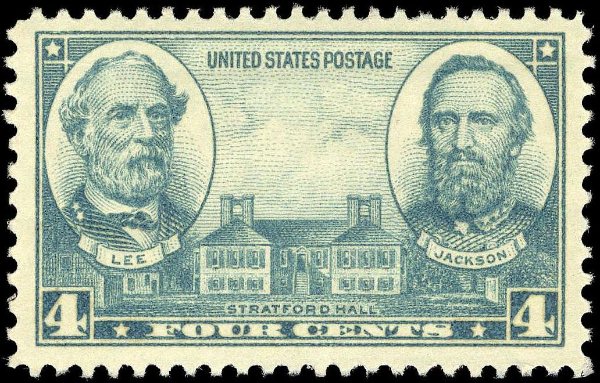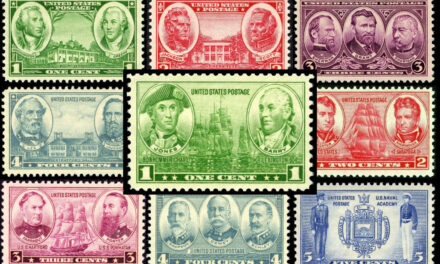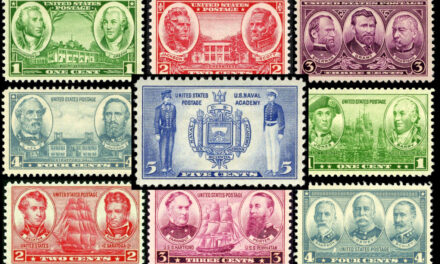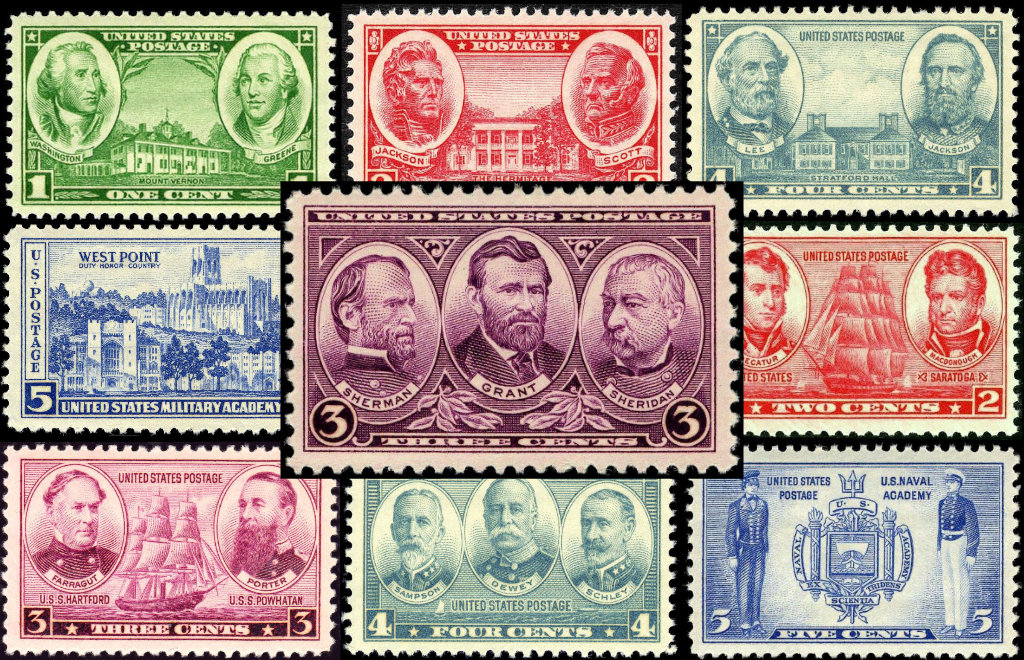
3-Cent 1937 Army Stamp: William Tecumseh Sherman, Ulysses S. Grant, and Philip Sheridan
The 3-cent 1937 Army stamp honors Civil War generals William Tecumseh Sherman, Ulysses S. Grant, and Philip Sheridan of the Union Army. The 3-cent stamp is the third in a series of five stamps that were issued between December 1936 and May 1937 to honor some of the most important 18th- and 19th-century Army officers in American history. It is the only one in the series to feature three officers.
The Post Office issued a parallel series of Navy commemoratives, including the 3-cent stamp honoring Admirals David Farragut and David Dixon Porter, on the same dates as the Army stamps.
The Design and Issuance of the 3-Cent 1937 Army Stamp

The 3-cent 1937 Army stamp features Generals William Tecumseh Sherman, Ulysses S. Grant, and Philip Sheridan. (U.S. Post Office — U.S. Bureau of Engraving and Printing, Public domain, via Wikimedia Commons)
The Other Stamps in the 1936–1937 Army Series
General of the Army William Tecumseh Sherman (1820–1891)
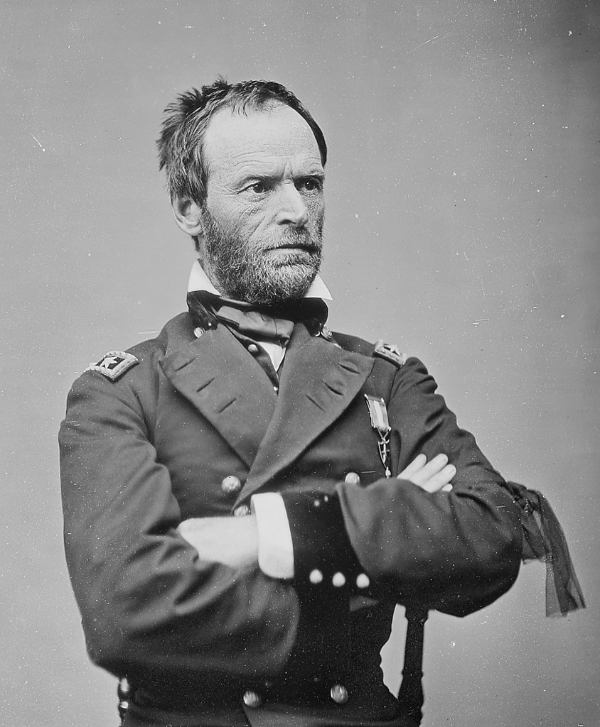
General William Tecumseh Sherman in a photograph by Matthew Brady. (The U.S. National Archives, Public domain, via Wikimedia Commons)
William Tecumseh Sherman graduated from the United States Military Academy at West Point in 1840 and entered the Army as a second lieutenant. He saw action in Florida against the Seminoles but was assigned to administrative duties during the Mexican-American War. After spending most of the 1850s as a businessman and educator, he volunteered for military service in 1861 and was commissioned as a colonel.
For two years, Sherman served under Ulysses S. Grant in the West and gained his confidence, playing a significant role in the capture of Vicksburg in 1863. When Grant took over command of all the Union armies, he appointed Sherman to succeed him in the West. Sherman marched on Atlanta and captured and burned the city in September 1864; he then completed his famous “March to the Sea” through Georgia by capturing Savannah in December.
Sherman was widely recognized as a brilliant strategist. When Grant became President, Sherman succeeded Grant in the rank of General of the Army and was appointed Commanding General of the United States.
General of the Army Ulysses S. Grant (1822–1885)

Ulysses S. Grant in a chromolithograph portrait, 1866. (Library of Congress Popular Graphic Arts, Public domain, via Wikimedia Commons)
An 1843 graduate of West Point, Ulysses S. Grant began his army career as a quartermaster, despite a reputation for expert horsemanship that would have made him a natural cavalry officer. He fought in the Mexican-American War (1846–1848) under Generals Zachary Taylor and Winfield Scott, although he strongly believed that the war was unjust. Grant served in the West for a few years after the war, but resigned from the army in 1854.
When the Civil War broke out, he joined the Union Army, and after early successes, he was promoted to the rank of major general. Grant earned a reputation as a courageous and determined leader at the bloody Battle of Shiloh in 1862. The following year, after a long and complex campaign and siege, Grant captured Vicksburg, gaining Union control of the Mississippi River and splitting the Confederacy.
Grant became Commanding General of the Union Army in 1864-1865 and coordinated the massive Overland Campaign that led to the defeat of the Confederacy and the surrender of Robert E. Lee at Appomattox.
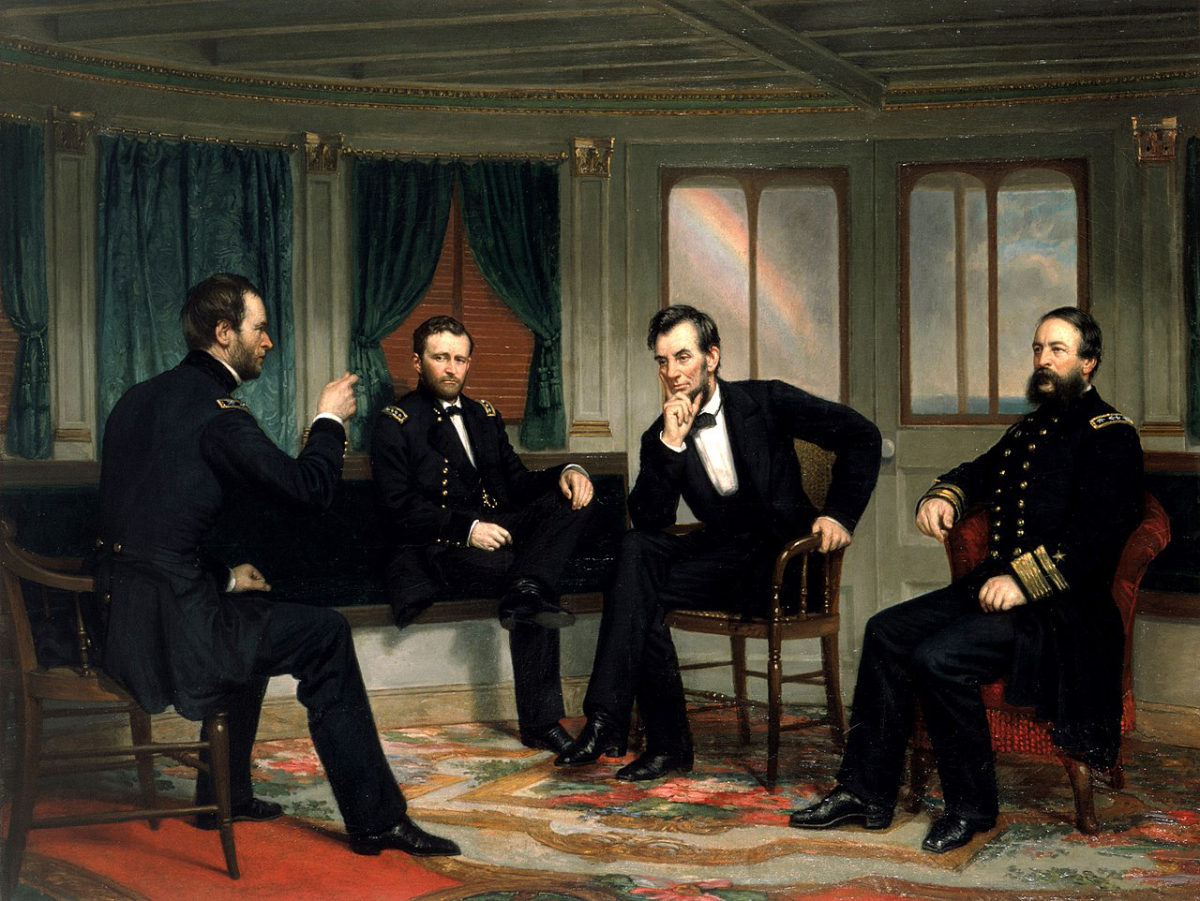
The Peacemakers, by George Peter Alexander Healey, 1868. Left to right: Major General William Tecumseh Sherman, Lieutenant General Ulysses S. Grant, President Abraham Lincoln, Vice Admiral David Dixon Porter. (Public domain, via Wikimedia Commons)
Grant remained in command after the war and took charge of Reconstruction in the South. He was elected as the 18th President of the United States in 1868 and served two terms.
General of the Army Philip Sheridan (1831–1888)
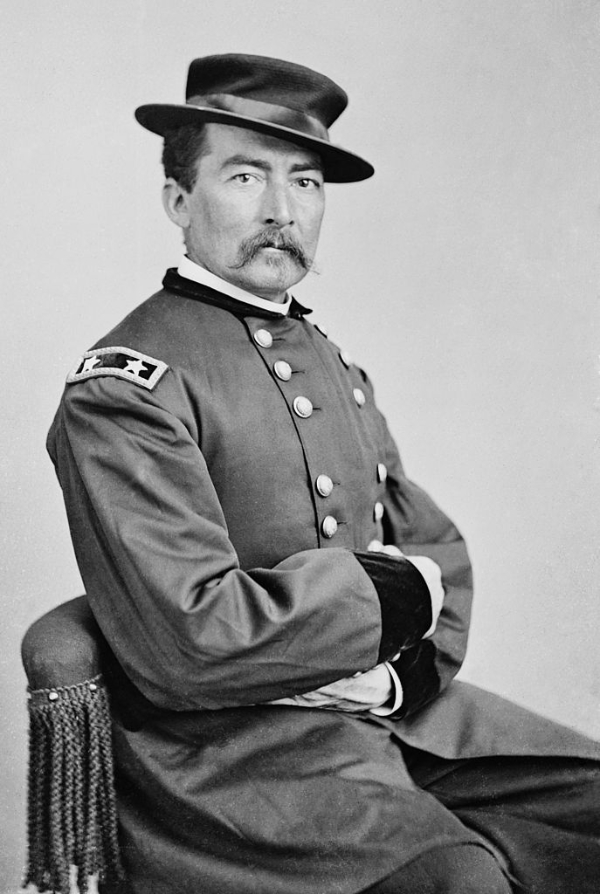
Portrait of Philip Sheridan, between 1855 and 1865. (Mathew Benjamin Brady, Public domain, via Wikimedia Commons)
Philip Sheridan served in the infantry in the Pacific Northwest following his graduation from West Point in 1853. After the attack on Fort Sumter in 1861, he was promoted to captain. First assigned as a staff officer, Sheridan was appointed colonel in the cavalry in May 1862. He distinguished himself and within six months was promoted to major general.
Sheridan continued to build a reputation for courage and aggressive battle tactics throughout 1863, and in the spring of 1864 Grant placed him in charge of the Cavalry Corps of the Army of the Potomac.
Sheridan’s troops had mixed success in the Overland Campaign, but he was given command of the Army of the Shenandoah in August 1864 and neutralized the Confederate Army in the area with scorched-earth tactics that became known as “The Burning.”
Sheridan’s actions in the Shenandoah Valley culminated at Cedar Creek, where he rode for ten miles to rally his troops against a surprise attack that had occurred while he was away. “Sherman’s Ride” was celebrated in a famous poem by Thomas Buchanan Read, which was used successfully in President Lincoln’s reelection campaign. Sherman capped his Civil War service with a determined pursuit of Robert E. Lee’s army, leading to Lee’s surrender at Appomattox.
During Reconstruction, Sheridan served as military governor of Texas and Louisiana. Assigned to pacify the Great Plains during the Indian Wars, Sheridan employed scorched earth tactics similar to those he had used in the Shenandoah Valley—including allowing professional hunters to slaughter the bison, the Indians’ primary source of food. On the positive side of the environmental ledger, Sheridan successfully crusaded for protection of the Yellowstone area against the railroads and developers, even sending in the cavalry to control the park.
In 1883, Sheridan succeeded Sherman as Commanding General of the U.S. Army, and in 1888, shortly before his death, he was promoted to the rank of General of the Army of the United States.
Portraits of American History
The 3-cent 1937 Army stamp honors the leadership of Generals William Tecumseh Sherman, Ulysses S. Grant, and Phillip Sheridan. Not only did these three men help guide the Union to victory in the Civil War, but they also played prominent roles in American life after the war.
This stamp, like the hundreds of others issued by the United States, can introduce students and others to important figures, places, and events in American history. There are so many stories to tell about the nation’s history. Commemorative postage stamps are a good place to look for them.
Copyright © Brian Lokker 2011, 2024. An earlier version of this article was published on HubPages.com in 2011 and was subsequently featured on HobbyLark.com.



